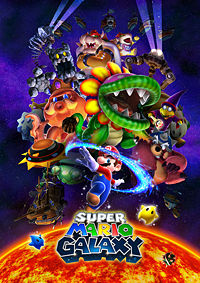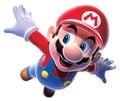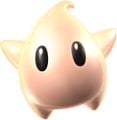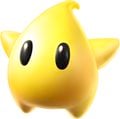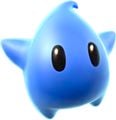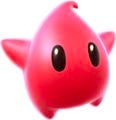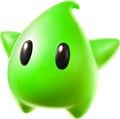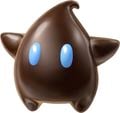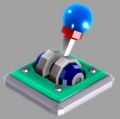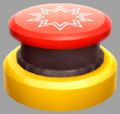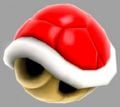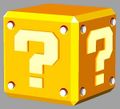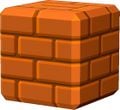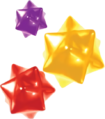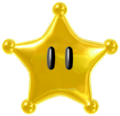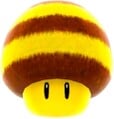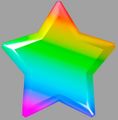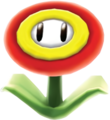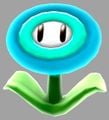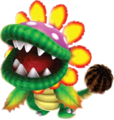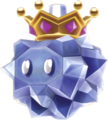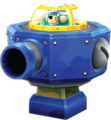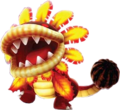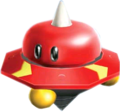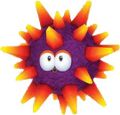Super Mario Galaxy: Difference between revisions
m (→Trivia) |
(Undid revision 740741 by Koji123456789 (talk)) |
||
| Line 586: | Line 586: | ||
*This is the first [[Mario]] 3-D game where a [[Wiggler]] does not appear as a boss, instead appearing as enemies. | *This is the first [[Mario]] 3-D game where a [[Wiggler]] does not appear as a boss, instead appearing as enemies. | ||
*GameStop erroneously stated that the game got an '''M''' (Mature, age 17+) rating. | *GameStop erroneously stated that the game got an '''M''' (Mature, age 17+) rating. | ||
==Names in Other Languages== | ==Names in Other Languages== | ||
Revision as of 18:08, April 9, 2010
Template:Articleabout Template:Infobox
Super Mario Galaxy is the third of Mario's 3-D platformers, and the follow-up to Super Mario 64 and Super Mario Sunshine. However, unlike the previous two 3D adventure installments for the Mario series, this game takes place in deep space. Most of the game's levels consist of many small planets and planetoids, while others have bigger planets. Upon release, Galaxy recieved some of the highest review scores and appraisals of any Wii game so far.
Story
Every hundred years, a comet passes over the Mushroom Kingdom and rains down magical stars and stardust. Princess Peach invites Mario to her castle to join in the festivities and receive a special gift. As the citizens of the kingdom are celebrating the centennial event, Bowser attacks the Toads with his airships and freezes them in crystals. He "invites" Peach to the creation of his new galaxy and warps into space with her castle to the center of the universe. When Mario tries to save her, a Magikoopa — presumably Kamek — throws a spell at Mario and sends him to a small planetoid.
When Mario later wakes up on the small grassy moon, he meets three Star Bunnies, who promise to tell Mario where he is if he catches them. When he does so, they take him to meet Rosalina, who tells Mario that the universe is in great peril after Bowser attacked her ship — the Comet Observatory — and stole the Power Stars, including seven Grand Stars. Without these, the Comet Observatory is doomed. Rosalina asks him to rescue the Grand Stars in order to defeat Bowser, who took Peach to the center of the universe. Mario then starts his journey across the galaxies, freeing Power- and Grand Stars. Once five of the Grand Stars are collected, the Comet Observatory becomes a starship and takes Mario to the center of the universe.
Here he defeats Bowser in his brand-new galaxy, retrieves the last Grand Star, and rescues Princess Peach. Without this Grand Star, the sun of Bowser's near-complete galaxy undergoes a supernova and becomes a supermassive black hole. Everything in the universe begins to fall in. The Lumas from the Comet Observatory, including the Luma who had faithfully accompanied Mario throguh his journey, throw themselves into the black hole in order to neutralize it. The Lumas attack the black hole's singularity, and it soon disintegrates in a massive explosion. Mario appears in front of Rosalina, who had somehow managed to save him from the cataclysm. She tells him that this is not the end, but a new beginning for the universe, and that the universe is an endless cycle, one that never repeats itself exactly the same way.
Mario later awakens in the Mushroom Kingdom near Peach's Castle. He sees everyone he's met throughout his adventure (friend and foe alike) celebrating, while Bowser and Peach sit next to him. When he looks in the air, he notices a new galaxy. "Welcome! Welcome new galaxy!" Mario exclaims, as the camera zooms out into space, revealing that his galaxy has been recreated. If the player continues with the file, Rosalina will state to the player that if he or she collects all 120 Power Stars, the player can travel to a new world. If the player finishes the game with 120 stars, a special cutscene plays after the credits. Rosalina and a group of Lumas appear on the planet Mario started on at the beginning of the game. Rosalina says "I'll be watching you from beyond the stars," and flies off to the Comet Observatory. Then, the white Luma is shown to be alive, now residing on the small planet.
This also unlocks the option to play as Luigi.
The Luigi Story goes exactly the same as Mario's, even with the Luigi that Mario rescued still being present. The only difference is that the Cosmic Luigi is smarter than the Cosmic Mario. When the player has defeated Bowser again and continues with the Luigi story, Rosalina will again say if Luigi collects all 120 stars, the player can travel to a new world. When the player collected 120 stars, the player can travel to Grand Finale Galaxy, the new world and the same new galaxy Mario saw in the ending movie. The 121st star can be found here. Template:Endspoiler
Gameplay
Controls
Super Mario Galaxy has several innovations and additions to the basic Mario 3D game concept. Mario is controlled with the analog stick and can jump with the A button. The Z button works just as the Z trigger did in Super Mario 64. The player uses it to make Mario crouch, do somersaults and do Long Jumps. The C button centers the camera behind Mario, while the D-Pad can adjust the camera angle manually.
The game also uses the motion-sensors of the Wii Remote. The pointer of the Remote appears as the Star Cursor on the screen. The Star Cursor is used to perform a variety of actions, such as using Pull Stars, manipulating Sling Pods, and collecting Star Bits. Shaking the Wii Remote or Nunchuck will make Mario perform a Spin.
By pressing B, players can fire a Star Bit. When enemies are hit by a Star Bit, they are stunned and can be defeated with a touch, releasing Star Bits. Mario can also defeat most enemies by jumping on them, which will create a healing coin. Using the Spin to defeat enemies is also possible. Spinning may also stop an enemy from attacking you like when Bowser uses his OWN Star Spin at you; both moves get cancelled. Also when Mario or Luigi Long Jumps then when they land on the ground and quickly do a star spin, they'll do a little piroutte like they're dancing. The player can use any of these tactics or only one of them during the entire game, as a specific tactic is never required to defeat a regular enemy. Only special enemies such as the Giant Goomba in the Gateway Galaxy might require a Spin. Several enemies are, however, much easier to defeat by shooting them than by jumping on them. As in Super Mario Sunshine, Mario can jump on NPCs to gain extra height or annoy them.
A "Co-Star" (Co-op) mode is available, in which the second player controls a second Star Cursor. The extra Star Cursor, unlike the main one, has the power to hold enemies still by pointing at them and holding A, shake bushes by moving the pointer across them, and push certain things around. It can also collect Star Bits and fire them. When the second Star Cursor is pointed at Mario and A is pressed, the second player can make Mario jump. Combining both jump techniques can make Mario jump higher than when only controlled with one controller.
Mario's life meter has been decreased to 3 total. Originally, the creators of Galaxy thought of giving Mario a 12- or 6-part health meter, but this idea was eventually considered far too easy. There is no longer a separate health bar for underwater levels which decreases slowly. Instead, Mario has an air meter which decreases and hurts Mario's health when it hits 0. The Life Mushroom replenishes any lost health and adds a second health meter, making Mario's max health six. When Mario's health drops down to 3 again, the effect of the Life Mushroom is lost.
Mario explores a 3D world with planets which have their own gravity. Several levels have arrows which Mario can turn around with a Spin, changing the direction of the gravity. The Launch Star allows Mario to launch off of a planet and go flying to the next. There is little or no warning that a boss might be located on the next planet, little indication that Mario may be facing something terrible or something peaceful on where he's headed next, and no loading times and screens. The game also contains side-scrolling levels reminiscent of New Super Mario Bros. with classic enemies such as Goombas and Piranha Plants. These side-scrolling levels may also contain no gravity, allowing Mario to walk on the ceiling.
Levels
Power Stars make a comeback. The goal of the game is to collect 60 stars and defeat Bowser. Similar to Princess Peach's Castle in Super Mario 64 and Delfino Plaza in Super Mario Sunshine, the Comet Observatory acts as the game's hub world. There, Mario can access the galaxies from Domes. New areas in the Comet Observatory become accessible as Mario gains Power Stars and Grand Stars. A minimum number of Power Stars is required to have enough power to go to each multi-star galaxy, single non-Grand Star galaxies with a ? Block icon when locked are bonuses for finishing certain star missions. The game has a level intro for each star, as in Super Mario Sunshine.
Mario encounters Luigi in three levels (in each of the Good Egg Galaxy, the Honeyhive Galaxy, and the Battlerock Galaxy), who helps him getting a secret star that Mario could not get alone. Mario receives a letter from Luigi every time Luigi has found a Power Star, including a picture which helps Mario find Luigi. After the main game is finished, Mario can return and collect up to 120 stars. Super Mario Galaxy contains a few different types of stars, including red, green, and comet stars. The Green Power Stars are secret stars which are used to unlock the Trial Galaxies and one Red Power Star appears when Mario returns to the gate, which allows usage of the Red Star in the Observatory.
After finishing a level, Mario's highest score of coins for the galaxy is recorded and the collected Star Bits are transferred to the Comet Observatory, where Mario can later use them to feed Hungry Lumas. The requirements for opening up each galaxy is listed below, with Star Bits if the galaxy is created by a Hungry Luma. Note, however, that some galaxies are not unlocked by simply obtaining a number of stars but by completing a specific star. This is true for all Hungry Lumas except the first, and all bonus galaxies from Buoy Base Galaxy onward.
The Gate
- Gateway Galaxy (completing King Kaliente's Spicy Return grants permanent access to this stage, and a second star)
The Terrace
- Good Egg Galaxy (1 star)
- Honeyhive Galaxy (3 stars)
- Loopdeeloop Galaxy (5 stars)
- Flipswitch Galaxy (7 stars)
- Bowser Jr.'s Robot Reactor (8 stars)
The Fountain
- Space Junk Galaxy (9 stars)
- Battlerock Galaxy (12 stars)
- Rolling Green Galaxy (11 stars)
- Hurry-Scurry Galaxy (18 stars)
- Bowser's Star Reactor (15 stars)
The Kitchen
- Beach Bowl Galaxy (16 stars)
- Ghostly Galaxy (20 stars)
- Bubble Breeze Galaxy (19 stars)
- Buoy Base Galaxy (30 stars and Sunken Treasure)
- Bowser Jr.'s Airship Armada (23 stars)
The Bedroom
- Gusty Garden Galaxy (24 stars)
- Freezeflame Galaxy (26 stars)
- Dusty Dune Galaxy (29 stars)
- Honeyclimb Galaxy (42 stars)
- Bowser's Dark Matter Plant (33 stars)
The Engine Room
- Gold Leaf Galaxy (34 stars)
- Sea Slide Galaxy (36 stars)
- Toy Time Galaxy (40 stars)
- Bonefin Galaxy (55 stars and Giant Eel Outbreak)
- Bowser Jr.'s Lava Reactor (45 stars)
The Garden
- Deep Dark Galaxy (46 stars)
- Dreadnought Galaxy (48 stars)
- Melty Molten Galaxy (52 stars)
- Matter Splatter Galaxy (50 stars and Heavy-Metal Mecha Bowser)
Hungry Luma Galaxies
After completing certain tasks, Hungry Lumas will appear outside of each dome in the Observatory, asking for a high quantity of star bits (Mario or Luigi will be able to use their total stash from all completed star missions, however). They will transform into whole galaxies when fully fed, each with one Power Star.
- Sweet Sweet Galaxy (outside of the Terrace, 7 stars, 400 star bits)
- Sling Pod Galaxy (outside of the Fountain, Tarantox's Tangled Web, 400 star bits)
- Drip Drop Galaxy (outside of the Kitchen, Sunken Treasure, 600 star bits)
- Bigmouth Galaxy (outside of the Bedroom, Soaring on the Desert Winds, 800 star bits)
- Sand Spiral Galaxy (outside of the Engine Room, Faster than a Speeding Penguin, 1000 star bits)
- Boo's Boneyard Galaxy (outside of the Gate, Gateway's Purple Coins, 1200 star bits)
- Snow Cap Galaxy (outside of the Garden, The Sinking Lava Spire, 1600 star bits)
The Center of the Universe
- Bowser's Galaxy Reactor (60 stars and Darkness on the Horizon)
The Trial Galaxies
The trial galaxies are slightly more difficult than the other galaxies, and require all 3 Green Power Stars to open up.
Green Power Star Locations
- Battlerock Galaxy, Luigi under the Saucer - Saving Luigi under the 1st Power Star.
- Dusty Dune Galaxy, Treasure of the Pyramid - Collecting 5 Silver Stars in the Pyramid Planet.
- Buoy Base Galaxy, The Secret of Buoy Base - Under the Buoy Base sealed in a cage.
The Grand Finale
- Grand Finale Galaxy (240 stars (120 stars with both Mario & Luigi))
Prankster Comets
- Main article: Prankster Comet
Prankster Comets are objects which interfere with a Galaxy, giving it an extra attribute. The 30 comet stars are obtained by completing special challenges in the larger galaxies, such as speed runs of certain missions, "daredevil" runs (in which Mario's max health is one), racing cosmic clones of Mario or Luigi, and double the speed of enemies. They only appear after the corresponding regular level (e.g. Ghostly Galaxy's Bouldergeist battle) is completed, sometimes immediately and sometimes only after another galaxy's level is completed. In some cases (like the Space Junk Galaxy), the entire galaxy has to be beaten first. There are 2 prankster comets in each of the 15 multi-star galaxies: one of the types of comets just described, plus one purple prankster comet that appears after beating Bowser's Galaxy Reactor for the first time, forcing missions where the player must collect 100 Purple Coins.
Forms
Mario regains his ability to gain different abilities via special mushrooms, flowers and stars, similar to Super Mario 64, in which he could obtain the Wing-, Vanish-, and Metal Caps. Mario transforms in the these forms with the stated items:
| File:BeeMario.jpg | File:BooMario.jpg | File:Ice Mario.jpg | 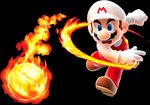
|
| Bee Mario, with the Bee Mushroom |
Boo Mario, with the Boo Mushroom |
Ice Mario, with the Ice Flower |
Fire Mario, with the Fire Flower |
| File:Springmario.jpg | File:SMG RainbowMario.jpg | File:Flying Mario Artwork.jpg | |
| Spring Mario, with the Spring Mushroom |
Rainbow Mario, with the Rainbow Star |
Flying Mario, with the Red Star |
Locations
Bee Mushroom
Boo Mushroom
Ice Flower
Fire Flower
Spring Mushroom
Rainbow Star
- Lots of Galaxies
Red Star
- Gateway Galaxy
- Comet Observatory(enabled by completing Gateway's Purple's Coins)
Characters
Mario encounters many new and old characters in his adventure. Most of these are met in one or more galaxies, though Rosalina, the Toad Brigade, and the Lumas are found on the Comet Observatory.
Enemies
The game has old enemies such as Goombas from Super Mario Bros. and round Goombas from Super Mario World, enemies which make their 3D debut such as Magikoopas and Dry Bones, as well as new enemies, which include the Electrogoombas and Mandibugs.
New Enemies
|
|
Returning Enemies
|
|
Bosses
Fifteen bosses are in the game. Some of them are fought more than once. The numbers below include Prankster Comet encounters.
- Dino Piranha x2
- King Kaliente x2
- Bugaboom x1
- Megaleg x1
- Kamella x3
- Tarantox x1
- Topmaniac x4
- Bouldergeist x2
- Major Burrows x2
- Baron Brr x1
- Undergrunt Gunner x3
- Kingfin x1
- Fiery Dino Piranha x1
- Bowser Jr. x1
- Bowser x3
Items
In Mario's new adventure, he uses many new and returning items that give him moves he's never had before.
Mini-Games
All except Bob-Omb Blasting can be found in the Trial Galaxies.
Unlockable Secrets
Once the player beats the game and gains 120 stars as Mario, he or she can go back to Rosalina and ask to fight Bowser again. Once Bowser is re-defeated, the Player unlocks the option to play as Luigi. He is slightly faster and jumps a bit higher than Mario, but he has less traction, and the Cosmic Luigi stars are more difficult to obtain, due to Cosmic Luigi using shortcuts and techniques not used by Cosmic Mario. Luigi's Spin also takes slightly longer to re-charge, and he has less air capacity than his brother. Luigi also loses air for every time he uses the Spin underwater. Once the player beats the game and collects 120 stars as Luigi, the 121st star becomes available.
When playing through the game as Luigi, the stars that required Mario to meet Luigi still feature a non-playable Luigi, bringing up the issue of two Luigis in the game. When the playable Luigi first saves the non-playable one from the Ghostly Galaxy, Luigi dismisses his rescuer merely as someone in the universe who happens to look like him. When Luigi rescues himself afterwards, the lost Luigi refers to him as "me" (for example, "I knew I could rely on... me!"). Rosalina dismisses the two as twins. At first, they appear to be exactly the same. However, if one looks closely at them, one will notice the playable Luigi is wearing lighter green clothes and is slightly shorter. When the Mailtoad has mail the letter will say it is for Mario and the Mailtoad will feel bad for you and give you 20 1-up Mushrooms.
If the player collects 9999 Star Bits, all the coconuts in the game turn into watermelons. They have the same use as coconuts but have a different colour scheme.
Letters
At various points in the game, the Mailtoad will give the player a letter and it will be sent to the Wii Message Board.
Whenever Luigi needs to be rescued after initially saving him from the Ghostly Galaxy, the letter will say:
Dear Mario,
Oh, no! It's horrible!
Luigi has gone missing!
What will we do!
Mailtoad
After rescuing Luigi each of these times, the letter will say:
Dear Mario,
Thank you for saving Luigi! Keep trying to rescue those Power Stars, and we'll do our best to help! ♪
Mailtoad
After getting the 121st star from the Grand Finale Galaxy, the letter will say:
Dear (player's name),
Congratulations! We would like to send you a galaxy sized thanks for saving all the Power Stars and playing to the very end.
Until next time;
The Super Mario Galaxy staff
Super Mario Galaxy: Original Soundtrack
- Main article: Super Mario Galaxy: Original Soundtrack
A soundtrack for the game has been released, called Super Mario Galaxy: Original Soundtrack. It is exclusive to Club Nintendo members in Japan and Europe. There is a one-disc edition and a two-disc Platinum edition. Both editions aren't available anymore at Club Nintendo Japan. In Club Nintendo Europe, both editions are still available, with the exception of The United Kingdom and Spain, which only have the regular edition.
Reception and Sequel
Famitsu Magazine has given Super Mario Galaxy a score of 19/20. To put that in perspective, Super Mario Sunshine was given 37/40 and Super Mario 64 39/40. The Official Nintendo Magazine UK gave the game 97%. It was called the best game of the decade and praised for having excellent graphics, sound and gameplay as well as a mixture of new features and classic features. Australia's longest-running unofficial multi-format gaming magazine - Hyper, scored the game 97 out of 100, tied for the highest score ever given in the history of the magazine, running since 1993. Also, it was voted by readers as the Game of the Year for 2007. The game placed 51st in the 200th Issue of GameInformer's "Top 200 Games of All Times".
At E3 2009, Super Mario Galaxy 2 was announced. This makes the Wii one of the few consoles since the Nintendo Entertainment System to feature more than one main Mario series title.
Media
Character Artwork
<showhide>
<show>
Mario Soaring - Galaxy MarioArtwork 00003.jpg
Mario Spinning - Tykemario.jpg
Mario and a Luma - Smg art 3.png
Mario Floating - Mantastar.jpg
- Rollstar.jpg
- Luigi 57.png
- PrincessRosetta.jpg
- SMG Toad.jpg
- QueenBee.jpg
- Bunny.png
- Penguin.png
- Coachsmg.PNG
- SpookySpeedster.png
</show></showhide>
Item Artwork
- Steponblock.jpg
- Questioningcoin.jpg
- SMG SpringMushroom.jpg
- SMG BooSuit.jpg
Enemy/Boss artwork
- Bugaboom.png
- SMG BowserJr.jpg
- BowserSMG.jpg
- BombBoo.png
- BulletBillsmg.PNG
- CheepCheepsmg.PNG
- SMG Magikoopa.jpg
- Pokey.png
- Thwomp.png
Advertisements
- Super-mario-galaxy-wp.jpg
Mario flying through the galaxy
Logos
- Galaxy Logo V1.jpg
The first logo design.
- Wii Super Mario Galaxy logo02.jpg
The second logo design.
- Logo SMG.jpg
The final logo design.
Quotes
For a full list of quotes, see here.
Beta Elements
- Main article: Super Mario Galaxy/Beta elements
Glitches
- Main article: Super Mario Galaxy/Glitches
Staff
- Main article: Super Mario Galaxy Staff
References to Other Games
- Super Mario 64- Both games begin with a letter being sent from Peach to Mario. Also the third and fourth star mission on the beach bowl galaxy feature a similar bit to Shifting Sands painting in Super Mario 64. (The Tox Boxes) Pushy Walls also return. The music of some Bowser galaxies are remixes of the original from Super Mario 64. Peach's Castle design is based on that of 64's, but with a few differences to it. Finally, in both games, after the credits and an ending screen is displayed, Mario would say "Thank you so much for playing my game!"
- Super Mario 64 DS- Both games begin with a letter being sent from Peach to Mario.
- Super Mario Sunshine- Fire Shooters and Water Shooters, which appear in various galaxies, have a strong resemblance to F.L.U.D.D's nozzle.
- Paper Mario- Both games begin with a letter being sent from Peach to Mario, also Bowser's way of kidnapping Peach (by stealing the whole castle) is reused here.
- Super Mario Bros. 3- Several pieces of music from this game are remixed here. Airships also return.
- Super Mario Bros.- Several sprites from this game appear here, including a planet in the Toy Time Galaxy, Mario sprites being in the background of a particular Bowser galaxy, and the background of the Flipswitch Galaxy resembling the overworld and underworld levels. Also, the main theme of the Toy Time Galaxy is a remix of the main theme.
- Pikmin 2- Captain Olimar's debt repaying ship appears in the Space Junk Galaxy.
- Pokemon- A giant Poke Ball planet makes a cameo appearance in Buoy Base Galaxy.
- Dr. Mario- A planet shaped like a giant Megavitamin cameos.
- Luigi's Mansion- When the player first sees Luigi, he is trapped in a Ghost House. The fact that Mario frees him is a direct spoof of Luigi's Mansion, as in Luigi's Mansion it was the direct opposite. Also the music that is being played when a boss tower is unlocked sounds suspusciously like the Luigi's Mansion Dark Room theme.
- Donkey Kong Jungle Beat- The flowers that Donkey Kong flings off of were reused in Super Mario Galaxy. In fact, Party Monkeys were originally going to appear as enemies, but were scrapped for unknown reasons.
- Yoshi's head makes a cameo appearance as a planet in the Space Junk Galaxy. The egg in the Good Egg Galaxy is the same as a Yoshi's. He can also be selected as the player's icon for a save game.
- Kirby - When Mario gets a Grand Star he rides it like Kirby rides a Warp Star.
References in Later Games
- Mario Kart Wii- Rosalina can be unlocked by having save data from Super Mario Galaxy, the Rainbow Road stage is set in space and full of star bits, which it's music is a remix of the Good Egg Galaxy theme. A Spiky Topman was a boss in an online tournament.
- New Play Control! Donkey Kong Jungle Beat- The Banana Banquet stage was based off of the Grand Finale Galaxy.
- Mario & Sonic at the Olympic Winter Games- One of the unlockable event needs players to fly and get points, which has a level that is similar to Good Egg Galaxy.
- Mario & Luigi: Bowser's Inside Story- The Spike Ball move used in the last boss fight returns in this game.
- New Super Mario Bros. Wii- The airship theme is a remix of the theme of Bowser Jr.'s Airship Armada (which itself is a remix of the Airship theme of Super Mario Bros. 3). During the credits, Peach reads the letter she sends to Mario at the beginning of the game.
Trivia
- Surfing 101 and The Galaxy's Greatest Wave have the same functions as Super Mario Sunshine's Ricco Harbor minigame Blooper Safari, with the Manta Ray replacing the Bloopers.
- People who pre-ordered Galaxy in the US got a small booklet and a commemorative coin with Mario soaring and a Luma on it.
- By coincidence, the title Super Mario Galaxy was first mentioned in a fan letter written to Nintendo Power by Jimmy Peterford of Glen Cove, New York. The letter in question, which was printed in the December 1991 issue, detailed a fantasy game system called the Raw Power System, which would come bundled with a game titled Super Mario Galaxy, but in Jimmy's words, would be "better known as Super Mario Bros. 24!"
- A trading card game was released featuring many characters, locations, and items from the game. [1]
- This is the first Mario 3-D game where a Wiggler does not appear as a boss, instead appearing as enemies.
- GameStop erroneously stated that the game got an M (Mature, age 17+) rating.
Names in Other Languages
References
External links
- Official Japanese Site
- Official American Site
- Official European Site
- Official Australian Website
- Official Korean Site
- Prologue Video (IGN)
- Super Mario Galaxy Reviews, Guide, Videos, Screenshots and more! (IGN)
